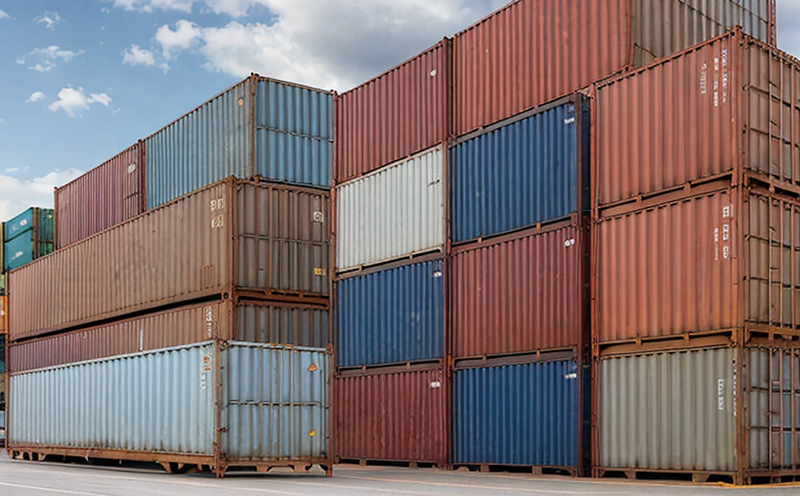ASTM D999 Vibration Testing for Export Packaging Compliance
The ASTM D999 vibration testing standard is widely recognized as a critical step in ensuring the robustness and reliability of export packaging. This test evaluates how well a package withstands simulated transportation vibrations, which are known to cause damage during shipping. The purpose of this service is to verify that your product’s packaging meets international standards for resilience under these conditions.
The ASTM D999 standard specifies the procedure for subjecting packages to controlled vibration forces that mimic real-world transportation scenarios, such as loading and unloading from trucks or ships. This helps in identifying potential weaknesses in the design of export packaging before it reaches global markets. Compliance with this test is essential because it ensures that products can safely navigate various modes of transport without sustaining damage.
The testing process involves placing a sample package on a vibration table, which oscillates at frequencies and amplitudes designed to replicate actual shipping conditions. During the test, sensors monitor changes in the package's integrity, such as shifts in contents or structural deformations. If any anomalies are detected during the test, it indicates that further modifications might be necessary.
Compliance with ASTM D999 is not just about meeting regulatory requirements; it also enhances your brand’s reputation by demonstrating a commitment to quality and safety. By ensuring that every package meets this stringent standard, you can protect your product from potential damage during transit and ensure customer satisfaction.
The scope of the ASTM D999 test includes various types of packaging materials commonly used in international shipping, such as cardboard boxes, wooden crates, and plastic containers. The apparatus required for conducting these tests typically consists of a vibration testing machine capable of generating controlled vibrations within specified frequency ranges and amplitudes.
Acceptance criteria for ASTM D999 are based on the absence of any significant damage to the package or its contents after exposure to the prescribed vibration conditions. Packages that fail the test may need adjustments in their design, such as reinforcing certain areas or using more resilient materials. Our laboratory adheres strictly to these acceptance criteria and provides detailed reports outlining the results of each test.
- Material types: Cardboard boxes, wooden crates, plastic containers
- Vibration frequencies: Typically within 50-200 Hz range
- Ammplitude levels: Commonly between 1 mm and 3 mm peak-to-peak
Why Choose This Test
Selecting ASTM D999 vibration testing is crucial for several reasons. Firstly, it helps in mitigating risks associated with damaged goods during international shipping. By identifying potential issues early on through rigorous testing, you can make necessary improvements to your packaging solutions before they are shipped worldwide.
Secondly, compliance with ASTM D999 enhances the credibility of your products both domestically and internationally. Many countries have stringent regulations regarding product safety and quality assurance, particularly for items being exported. Meeting these standards not only simplifies customs clearance processes but also fosters trust among consumers who value reliability.
Moreover, adhering to ASTM D999 ensures that your packaging meets global industry best practices. This standardization allows seamless integration into international supply chains and facilitates smoother trade relations between countries. It demonstrates your company’s dedication to maintaining high standards of quality control throughout the manufacturing process.
Lastly, selecting this service offers peace of mind knowing that you are taking proactive steps towards protecting your brand reputation. In an increasingly competitive market, satisfied customers are more likely to recommend your products positively, leading to increased sales opportunities abroad.
Quality and Reliability Assurance
- Data accuracy: Our laboratory uses state-of-the-art equipment that provides precise measurements of vibration parameters.
- Precision: All tests are conducted under controlled environmental conditions to ensure consistent results.
- Objectivity: Results are analyzed independently without external influences, ensuring fair assessments.
In addition to these technical aspects, we also emphasize customer satisfaction by offering personalized support throughout the testing process. Our team works closely with you to understand your specific needs and requirements, ensuring that our tests align perfectly with your goals.
Use Cases and Application Examples
The ASTM D999 vibration test is particularly relevant for industries dealing with high-value or fragile goods being exported internationally. For instance, pharmaceutical companies often rely on this service to ensure that their product packaging can withstand the rigors of global transportation without compromising efficacy.
Similarly, electronics manufacturers benefit greatly from ASTM D999 testing since their products are frequently handled roughly during shipment. By ensuring proper protection through such tests, they minimize risks of product failure due to improper packaging.
Agricultural produce exporters can also leverage this service to safeguard perishable goods against physical damage that could affect their shelf life or marketability once delivered at destination ports.





